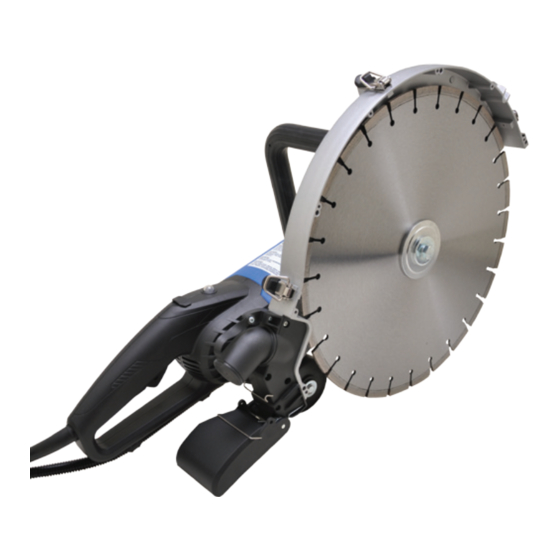DIAQUIP QHS-400 Gebruikershandleiding - Pagina 10
Blader online of download pdf Gebruikershandleiding voor {categorie_naam} DIAQUIP QHS-400. DIAQUIP QHS-400 18 pagina's. Electric handsaw

DIAMOND BLADES
About Diamond Blades (continued)
See below: "SHARPENING A GLAZED BLADE"
Never use a sharp motion or the blade will be damaged. Conversely, don't feed too gently
or the diamond segments will become glazed. Keep the blade steadily working, but don't be
abusive or give the blade shock impacts into the work surface.
Take great care to keep the blade perpendicularly aligned to the kerf. If the blade is crooked,
it will easily bind. When cutting reinforced concrete, if embedded steel such as rebar is
encountered, take special care. When the steel is encountered, the water will generally go
clear and vibration will begin. Reduce the feed pressure by about 1/3 and let the blade go at its
own pace, if there is too much vibration the blade may be destroyed. Once the steel is passed,
continue normally. A properly sharp blade with good diamond exposure should be able to
cut through rebar if handled well.
NOTE: Never use a wet-type diamond blade without water. It will overheat and be
destroyed.
NOTE: When using dry blades, do not allow them to overheat. It is best to cut no longer
than about 60 seconds at a time, with 10 second running in air cool down times in
between.
Always mount the blade with the arrow matching the direction of rotation of the machine (A
direction arrow is marked on the blade guard).
WARNING: Never use blades for cutting a material other than the material they were
intended for.
SHARPENING A GLAZED BLADE
Diamond blades may become glazed (dull) for various reasons, such as cutting reinforced
concrete with an excess of embedded steel, or from cutting with too little downforce which can
lead to the segments becoming polished or "glazed". Once the diamond segments are glazed,
the blade's cutting performance will degrade and the segments will overheat. To resharpen the
blade, turn down the water feed and make a few cuts in a very soft, abrasive material such as
brick.
/18
MOUNTING THE BLADE
First make sure that the machine is unplugged.
Then, using the 17mm combination wrench, engage the arbor bolt and turn the arbor while
pressing on the arbor lock (See page 2). When the arbor reaches the right position, the arbor
lock will be allowed to engage. Then the arbor bolt may be loosened and the plain outer flange
may be removed. (It is a standard, right hand thread, so turn anticlockwise to loosen.)
The inner flanges are specific to the blade arbor bore diameter. There are three possible blade
arbor bore sizes depending on the market where the machine is sold: 20mm, 22.2mm (7/8"),
and 25.4mm (1") Check the inner flange to ensure that the size matches the bore of the blade
which you intend to use.
The 7/8" and 1" sizes each have a specific inner flange which must be used. For the 20mm
size, the bore directly engages the arbor and thus uses a plain flange on both the inside and
outside.
Inspect the blade before use. It must not be cracked, warped or damaged in any way that would
cause a hazard in operation. Loose diamond segments can be ejected at high speed, causing
possible injury. Always check that the diamond segments are not under cut. If the diamond
segments are thinner or nearly thinner than the blade core, the kerf will be too tight fitting and
could easily lead to kickback.
Ensure that the flanges and blade bore are clean and undamaged and that everything fits
properly. The flanges may not be used if they are warped, the surface is uneven, burred or if
they are dirty. The arbor bolt and arbor threads must be undamaged. Inspect the blades for
segment damage, arbor hole damage or any other damage which could cause hazardous
operation.
The protruding edge of the inner flange should be facing the blade. Then mount the blade to the
inner flange and add the outer flange. Add the arbor bolt and tighten to 15-25 Nm.
WARNING: Do not attempt to mount a blade which does not match the mounting
hardware. It will lead to eccentric running and vibration which will be uncontrollable.
WWW.DIAQUIP.CO.UK
WWW.DIAQUIP.CO.UK
/19
